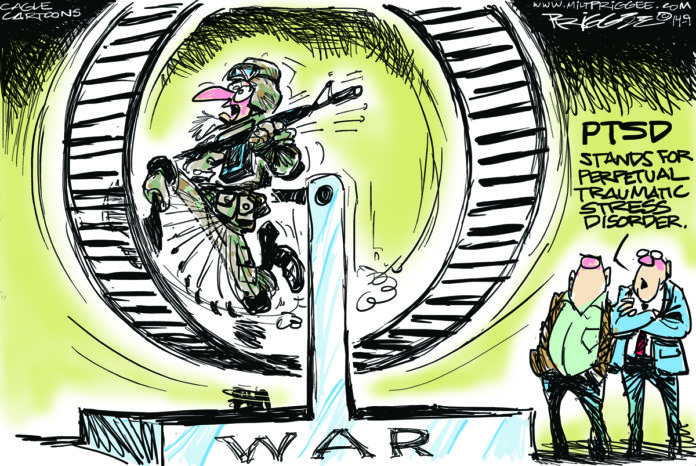BY RAY PEARCEY
How can a society gauge the current intentions, as opposed to the capacity, or the history of an enemy, even an arguably extremely dangerous foe? And when, if ever, is transcendent violence justified in a military contest?
Is it, as George Bush did during America’s second Iraq war, ever OK to launch a preventive war? Is deception in military engagements ever acceptable, even if your own troops are the primary victims?
When should a society conclude, as Barack Obama has apparently reluctantly decided vis a vis the death cult/mobile kill cadre called ISIS, that negotiations with an enemy are pointless?
These kinds of questions loomed large over U.S./Soviet relations during the entire Cold War face off; we are revisiting some of them just now with ISIL and Russian adventurism in Ukraine.
And we could say they were the wheelhouse, the driving dynamo during the nearly civilization-ending encounters between Soviet Premier Nikita Khrushchev and the brand-new, untested American President John F. Kennedy, during the 1962 Cuban missile crisis.
Recently, I watched a film released last year – a provocative, big budget science fiction piece with lots of newly relevant ethical dynamics. Gavin Hood, director of Ender’s Game, tussles with these world-beater queries, questions that Western and Asian societies have pondered in recent history:
Consider the shouting, the yelling among academics, U.S. and Japanese partisans over the logic, the moral rectitude of the Hiroshima and Nagasaki bombings. Or the morality of the German civilian bomber sorties over wartime London in the 1940s. Or the vast World War II American fire bombings of largely wooden Japanese cities.
CARD’S LOOK AHEAD
In a prescient, almost freakish fashion, Ender’s Game, Orson Scott Card’s 1985 science fiction novel, took a nearly 30 years in advance peek at an array of morally freighted matters that weigh heavily on us today: the impacts of ultra violent computers games on kids and adult soldier trainees; hyper realistic simulations that may trivialize monstrous real world battlements; and heavy use of remote killings, drones and advanced automation in war fighting.
And the film adaption of Ender’s is a pretty fateful rendition of the book – a reimagine made very potent by digital wizardry, performance animation and electrifying cinematography.
CHILD FIGHTERS
The idea of children as soldiers is bizarre and far outside the realm of a morally acceptable practice among most Americans. It is one of the reasons why some of the exotic African, Asian and Middle Eastern micro wars of the 1990s and 2000s – fetid entanglements that have been powered by child warriors – are so incomprehensible, repugnant to most Western observers.
Having said that, why is it that kid soldiers keep showing up as central players in current American films?
One of last year’s most widely anticipated films was Hunger Games: Catching Fire, a sci-fi/fantasy film about a post-apocalyptic world with a very powerful 1% surrounded by impoverished, defeated countryfolk on every side.
But the core of the story is an annual event wherein the rulers “show” the under-population, in a strange concession, honoring their overlords by allowing the underclass to engage in special games against their child peers in the “colonies.”
The Hunger Games allowed subjugated countryfolk to show their ability and prowess while the ruling 1% percent gets to watch these battles for fun and entertainment.
Ender’s Game, likewise, details a sad, deeply embattled planetary future: an Earth still recovering from a savage alien attack; one that saw many millions of humans perish 50 years earlier.
In the movie, the planet’s leaders have decided that the best fighters, the most talented warrior cadre, are techno adapt, intellectually gifted, high agility children, selected via a hyper competitive, all world process. The movie is tethered to a small tribe of children who will lead the battle against the alien forces, when the time is right.
ENDER’S
The child star of the Ender’s is Asa Butterfield, the charismatic kid actor who graced Martin Scorsese’s 2010 masterpiece Hugo. Adult players included the compelling Viola Davis, star of the new ABC forensic mystery series, How To Get Away With Murder and an outsized presence in Doubt, a Philip Seymour Hoffman instant classic and Solaris, a little seen science fiction/George Clooney vehicle. And Harrison Ford, of too many movies to name, is majordomo in the film.
Ender’s makes fantastic use of special-effects in the powerful depiction of the training/epic play setting that occupies much of the film. At the center of the movie is a giant practice warren, high above Earth, where warrior children are instructed on space borne tactics, team cohesion and stealth. All in the service of what to do when the Formix – a bug like alien civilization that five decades earlier sought to place a colony on Earth without permission, and killed millions of human beings in their unsuccessful occupation – stage a return.
A passel of the visual power of the flick flows from the many splendid space launch and orbiting Earth battle prep station shots: optical jewels apparently inspired by SpaceX CEO, Elon Musk, an advisor to the movie.
THE LITTLE GAME
There is a astonishing computer game that lead actor Asa Butterfield plays at intervals in the movie. The wholly animated sequences that render the game events are almost a set of stand alone pieces within the larger film.
In the game, a tablet-based piece, Ender’s takes on the persona of a rat challenged by a grim desert environment, one packed with animal predators and middle borne explosions. But Ender’s is soon to be challenged even further by a giant in the game who encourages Ender’s rat to take a sip from one of two cups – maintaining that one is safe.
Ender’s jumps to the top of a table, leaps into one of the cups and is destroyed: eliminated from the game. In the next round of the game, Ender’s rat avatar again jumps into one of the cups, where he is eviscerated for a second time.
In the next round of the game, the rat nervously ponders what course to follow and takes an unexpected path: he jumps into one of the eyes of the untrustworthy giant. Ender’s move is wildly applauded by Harrison Ford and Viola Davis, commander and crew supervising psychologist/trainer, respectively. Both have unfettered access to kid Ender’s world via a sort of neural camera – and can see, really witness, every situation he encounters.
Near the end of the film, we get to see the tragic, wrenching importance of the little game – in a way that’s not obvious.
TRAINING ROOM
The epic training facility is a weightless stadium like super room with no bottom or top. It’s where most of the film takes place. In this room, Ender’s and his teammates try to prevail over other teams of kids who have been recruited, all angling for the top – that is, the opportunity to deliver hell to the Formix enemy when the war gets underway again.
This is a world in which motion and gestures allow one to control giant machines, with devastating outcomes and often with great precision.
But it’s also a world where matchless computer simulations – really gigantic, immersive video games with radical enhancements and full body play – are at work.
Ender’s and his teammates control what seems to be a training world – one filled with all the spacecraft, drones and troops they will need to confrontation the aliens.
The film ends with a huge, monstrous surprise; I won’t give it away here.
So … want to watch a visually spectacular, effects-laden film filled with celebrated actors and really complex moral dilemmas?
If you’re up for these things, Ender’s Game is for you.
– Ray Pearcey is a technology and public policy consultant, editor of The Oklahoma Eagle and a columnist for The Tulsa Voice.








